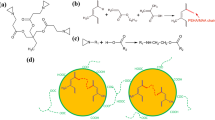Abstract
Grafting reactions between different acrylates (methyl, ethyl, butyl, hexyl, and lauryl) and natural rubber latex (NRL) were performed in miniemulsion. It is observed that polyacrylates with longer alkyl chain length, i.e., ≥4 carbons, only produce stable dispersions with the hydrophobic azo initiator 2,2′-azobis(2-methylbutyronitrile) (V59). Increasing the reaction temperature from 5 to 72 °C with different initiating systems increases the gel content of the butyl acrylate (BA)-modified NRL. Solid-state 1H MAS NMR was employed to accurately calculate the grafting efficiency of polyacrylate-modified NRL. Initiating systems such as 2,2′-azobis(4-methoxy-2.4-dimethyl valeronitrile) (V70) and cumene hydroperoxide yield the maximum grafting of ∼53 wt.% efficiency of BA (compared to the BA used) on NRL whereas an enzyme initiator yields the lowest grafting efficiency of 18.3 wt.%. The reaction with V59 as initiator shows the intermediate grafting efficiency of 37 wt.%. Increasing the BA amount from 16.4 to 26.6 wt.% increases the gel content to 47 and 68 wt.%, respectively. The grafting efficiency of BA on NRL is constant at ∼35 wt.% for BA contents from 16.4 to 22.7 wt.%, but for further increasing BA amount to 27 wt.%, a 3.7 times higher grafting efficiency of BA on NRL was observed compared to the other two lower concentrations of BA. Film-forming properties and DSC analysis were used to investigate the phase behavior of polyacrylate-blended and grafted NRL materials; transmission electron microscopy was used to investigate the morphology of BA-grafted NRL.






Similar content being viewed by others
References
Arayapranee W, Rempel GLJ (2008) Appl Polym Sci 109:1395–1402
Daniel D, Punyanich I, Ngoc TQ, Frédéric G, Charoen N (2009) Eur Polym J 45:820–836
Lee D-Y, Subramaniam N, Fellows CM, Gilbert RGJ (2002) Polym Sci A Polym Chem 40:809–822
Oliveiraa PC, Guimaraes A, Cavaille J-Y, Chazeauc L, Gilbertb RG, Santosa AM (2005) Polymer 46:1105–1111
Bielawski CW, Jethmalani JM, Grubbs RH (2003) Polymer 44:3721–3726
Schneider M, Pith T, Lambla MJ (1996) Appl Polym Sci 62:273–290
Landfester K (2006) Annu Rev Mater Res 36:231–279
Landfester K (2009) Angew Chem Int Edit 48:4488–4507
Brandrup J, Immergut EH, Grulke EA (1999) Polymer Handbook, 4th ed, Wiley
Alger MSM (1989) Polymer science dictionary. Elsevier, London
Choi KJ, Lee GH, Ahn SJ, Shon KH, Kim I, Jeong HMJ (1996) Appl Polym Sci 59:557–560
Machado JM, Lee CS (1994) Polym Eng Sci 34:59–68
Zachariah O, Sabu T (1993) Polym Bull 31:623–628
Subramaniam N, Simpson A, Monteiro MJ, Shaffer O, Fellows CM, Gilbert RG (2004) Microscop Res Tech 63:111–114
Jing P, Maolin W, Jinliang Q, Genshuan W (2005) Rad Phys Chem 72:739–743
Jin KK, Won CH, Jong YK (2003) Eur Polym J 39:1249–1265
Author information
Authors and Affiliations
Corresponding author
Additional information
An erratum to this article can be found at http://dx.doi.org/10.1007/s00396-011-2409-9
Electronic supplementary material
Rights and permissions
About this article
Cite this article
Ragupathy, L., Ziener, U., Robert, G. et al. Grafting polyacrylates on natural rubber latex by miniemulsion polymerization. Colloid Polym Sci 289, 229–235 (2011). https://doi.org/10.1007/s00396-010-2360-1
Received:
Revised:
Accepted:
Published:
Issue Date:
DOI: https://doi.org/10.1007/s00396-010-2360-1




